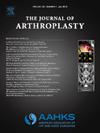Porous Metal Augments Have Comparable Outcomes to Other Constructs for Severe Acetabular Bone Loss at Mid-Term Follow-up
IF 3.4
2区 医学
Q1 ORTHOPEDICS
引用次数: 0
Abstract
Background
Acetabular reconstruction options in the setting of severe bone loss remain limited, with few comparative studies published to date. The purpose of this study was to compare the outcomes of revision total hip arthroplasty (THA) for severe bone loss using porous metal augments to cup cage and triflange prostheses.
Methods
We reviewed a consecutive series of 180 patients who had Paprosky 3A or 3B acetabular defects and underwent revision THA. Patients treated with porous augments (n = 141) were compared with those who received cup cages or triflange constructs (n = 39). Failure of the acetabular construct was defined as undergoing acetabular revision surgery or radiographic evidence of loosening.
Results
There was no difference in acetabular component survivorship in patients undergoing revision THA with porous augments or a cage or triflange prosthesis (92.2 versus 87.2%, P = .470) at a mean follow-up of 6.6 ± 3.4 years. Overall, survivorship free from any revision surgery was comparable between the 2 groups (78.7 versus 79.5%, P = .720). There was also no difference in dislocation (5.7 versus 10.3%, P = .309) or periprosthetic joint infection rates (7.8 versus 10.3%, P = .623). In a subgroup analysis of patients who had pelvic discontinuity (n = 47), survivorship free from any revision surgery was comparable between the 2 groups (79.5 versus 72.2%, P = .543).
Conclusions
Porous metal augments in the setting of severe acetabular bone loss demonstrated excellent survivorship at intermediate-term (mean 6.6 years follow-up, even in cases of pelvic discontinuity, with comparable outcomes to cup cages and triflanges. Instability and infection remain major causes of failure in this patient population, and long-term follow-up is needed.
在平均 6.6 年的随访中,多孔金属假体治疗严重髋臼骨缺损的效果与其他假体相当。
导言:严重骨质流失情况下的髋臼重建方案仍然有限,迄今为止发表的比较研究很少。本研究的目的是比较使用多孔金属增量体和杯笼及三瓣假体对严重骨质疏松患者进行翻修全髋关节置换术(THA)的效果:我们对 180 名患有 Paprosky 3A 或 3B 髋臼缺损并接受翻修全髋关节置换术的患者进行了连续系列研究。使用多孔增量假体治疗的患者(n = 141)与使用杯笼或三凸缘假体治疗的患者(n = 39)进行了比较。髋臼结构失败的定义是接受髋臼翻修手术或放射学证据显示有松动:结果:在平均6.6 ± 3.4年的随访中,使用多孔增量体或卡环或三凸缘假体进行翻修THA的患者的髋臼组件存活率没有差异(92.2%对87.2%,P = 0.470)。两组患者无翻修手术的总体存活率相当(78.7% 对 79.5%,P = 0.720)。脱位率(5.7% 对 10.3%,P = 0.309)或假体周围关节感染率(7.8% 对 10.3%,P = 0.623)也没有差异。在对骨盆不连续的患者(n = 47)进行的亚组分析中,两组患者接受翻修手术后的存活率相当(79.5% 对 72.2%,P = 0.543):结论:在髋臼骨严重缺失的情况下,多孔金属增量器在中期(平均 6.6 年)随访中表现出良好的存活率,即使在骨盆不连续的病例中也是如此,其结果与杯笼和三法兰相当。不稳定性和感染仍然是导致这类患者失败的主要原因,因此需要进行长期随访。
本文章由计算机程序翻译,如有差异,请以英文原文为准。
求助全文
约1分钟内获得全文
求助全文
来源期刊

Journal of Arthroplasty
医学-整形外科
CiteScore
7.00
自引率
20.00%
发文量
734
审稿时长
48 days
期刊介绍:
The Journal of Arthroplasty brings together the clinical and scientific foundations for joint replacement. This peer-reviewed journal publishes original research and manuscripts of the highest quality from all areas relating to joint replacement or the treatment of its complications, including those dealing with clinical series and experience, prosthetic design, biomechanics, biomaterials, metallurgy, biologic response to arthroplasty materials in vivo and in vitro.
 求助内容:
求助内容: 应助结果提醒方式:
应助结果提醒方式:


